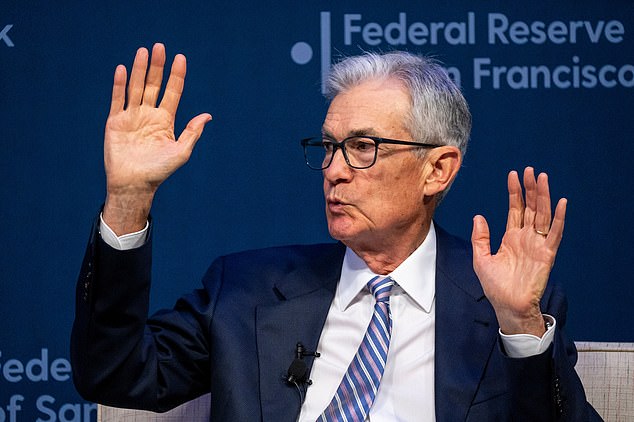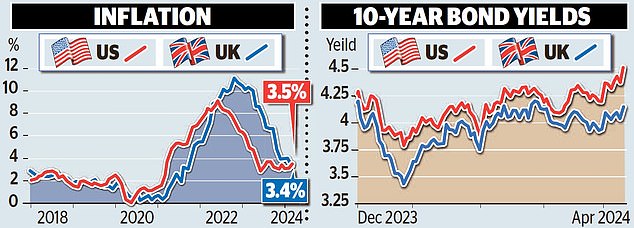<!–
<!–
<!– <!–
<!–
<!–
<!–
Hopes for interest rate cuts faded yesterday on both sides of the Atlantic after US inflation rose to a higher-than-expected 3.5 percent.
The figures wreaked havoc on financial markets as bond yields soared, Wall Street stocks plunged and the pound fell sharply.
Paul Ashworth, chief North American economist at Capital Economics, said the data “all but ends hopes of a June rate cut” by the Federal Reserve.
And Larry Summers, former US Treasury Secretary, said this could even mean that the US central bank’s next move will be an increase.
Market bets on the timing of a Bank of England rate cut were also delayed (from June to August) as the likely Federal Reserve delay gave Threadneedle Street officials pause.

Setback: The US Federal Reserve, chaired by Jerome Powell (pictured), is expected to shelve any rate cut plans following the latest inflation figures.
But the chances of the Bank acting first have now increased, causing the pound to fall sharply against the dollar to $1.25 yesterday.
Investors will also focus on the European Central Bank’s plans when it announces its rate decision today, although it is not expected to act yet.
US inflation data showed that annual consumer price inflation in the world’s largest economy rose from 3.2 percent in February to 3.5 percent in March. Economists had forecast a smaller increase, up to 3.4 percent.
It was the third consecutive month in which the inflation figure was higher than expected.
Markets were also alarmed that a “core” measure of inflation, which excludes volatile food and energy costs, remained at a persistently high 3.8 percent. It had been predicted that it would fall.
The numbers are likely to alter plans by the Federal Reserve, chaired by Jerome Powell, to cut rates this year. Last month, he signaled he was likely to cut rates three times in 2024.
But now financial markets are betting that there will only be two and that the likely start date will be in September rather than June.
Summers told Bloomberg TV: “You have to take seriously the possibility that the next rate move is up rather than down.”
In New York, the S&P 500, Dow Jones and Nasdaq stock indices fell about 1 percent.


Ten-year U.S. bond yields – the rate investors charge to lend to the government – rose above 4.5 percent, the highest level since November.
UK 10-year bond yields rose to almost 4.2 percent, the highest level in a month.
Bob Doll, chief investment officer at Crossmark Global Investments, said: ‘This is the third month in a row that the report has been more interesting than expected.
“So what you’re saying is that inflation is not under control and therefore the Fed is unlikely to lower rates anytime soon.”
Speculation has been mounting about the timing of an interest rate cut in the United States.
The US central bank raised rates aggressively throughout 2022 and in the first half of 2023 as it struggled to reduce inflation.
It appeared to be winning when inflation fell to 3 percent last summer, but has since stubbornly refused to fall further toward its 2 percent target.
Now Britain is catching up, with inflation falling to 3.4 percent in February and expected to have fallen further when March figures are published next week.
That could mean UK inflation is below that of the US for the first time in two years.
Daniele Antonucci, chief investment officer at private bank Quintet, said the timing of a Fed rate cut was “now more uncertain than ever.”
“We see a greater chance that the European Central Bank and the Bank of England will begin their rate cutting cycle before the Federal Reserve,” he added.
